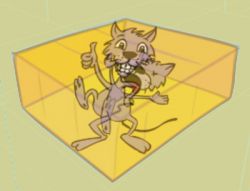
[2013-09-27] Researchers from Yale University and quantum physicist Gerhard Kichmair have recently succeeded in encoding the quantum information of a superconducting quantum bit in more than 100 entangled photons. The method, published in Science, could be the foundation for a new type of quantum memory.
French physicist Serge Haroche, nobel laureate in physics in 2012, trapped atoms and photons in small cavities made of reflecting walls. This device allowed him to experimentally study the nature of the quantum states of light. Researchers from Yale University in New Haven, USA, have used a similar cavity resonator to realize the first main building block for a new type of quantum memory.
Gerhard Kirchmair, experimental physicist in Innsbruck, also participated in the experiment: “We devised a new method for efficiently creating Schroedinger 'cat states' in a waveguide resonator with microwave photons.” Erwin Schroedinger illustrated macroscopic quantum states in a thought experiment using a cat that can be dead or alive at the same time. A similar thing happens with an electrical field generated by the photons in the waveguide resonator. It points in one or more directions at the same time. These Schroedinger cat states had been realized experimentally before but with this new method it will be easier and the experimental set-up will be simpler. “Moreover, we can create very large Schroedinger cats,” says an excited Gerhard Kirchmair. “It is possible to prepare up to one hundred photons in a quantum mechanical superposition state and to measure and control this state.” Nobody had created this size of Schroedinger cat states in a cavity resonator before.
Schroedinger cats as quantum memories
Robert Schoelkopf's research group from Yale University use these cat states to store quantum information. They couple the photons in the waveguide resonator to a quantum bit realized with a so called Josephson junction, which consists of two superconductors separated by a very thin isolating oxide film. These superconducting qubits can easily be coupled to conventional electrical circuits. With this setup the researchers are now able to deterministically encode the quantum information of the superconducting qubit in a Schroedinger cat state of more than 100 photons. “This experiment shows the potential of this type of waveguide resonators for quantum information processing,” says Gerhard Kirchmair. “This work is the first step towards realizing our proposal of a new type of quantum memory recently published in Physical Review Letters,” explains Kirchmair. “Moreover, current experiments have shown first promising results to correct errors in the quantum memory caused by photon loss.” Quantum information stored in these memories would not be destroyed by external noise.
Strong addition to quantum centre Innsbruck
In March 2013, Gerhard Kirchmair started his post as Professor for Experimental Physics, which is limited to five years, at the University of Innsbruck. He is also Junior Research Director at the Institute for Quantum Optics and Quantum Information (IQOQI) of the Austrian Academy of Sciences. His post is part of a project initiated by physical theorist Peter Zoller and is similar to a tenure-track process. The goal is to give young scientists more opportunities at Austrian universities. Kirchmair graduated in physics at the University of Innsbruck and received his doctorate sub auspiciis with experimental physicist Rainer Blatt. For two years, he worked as a postdoc in Rob Schoelkopf’s research group at the renowned Yale University in New Haven, USA.